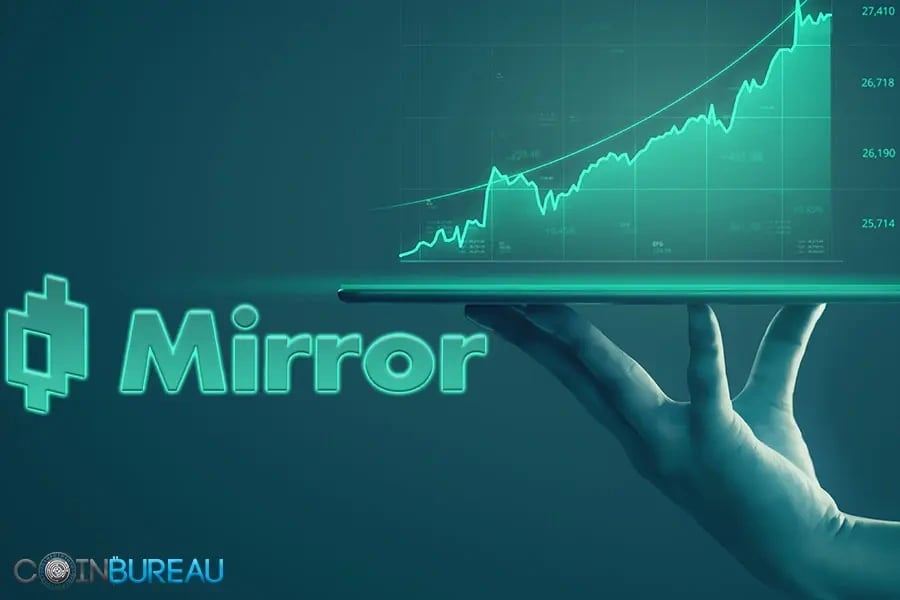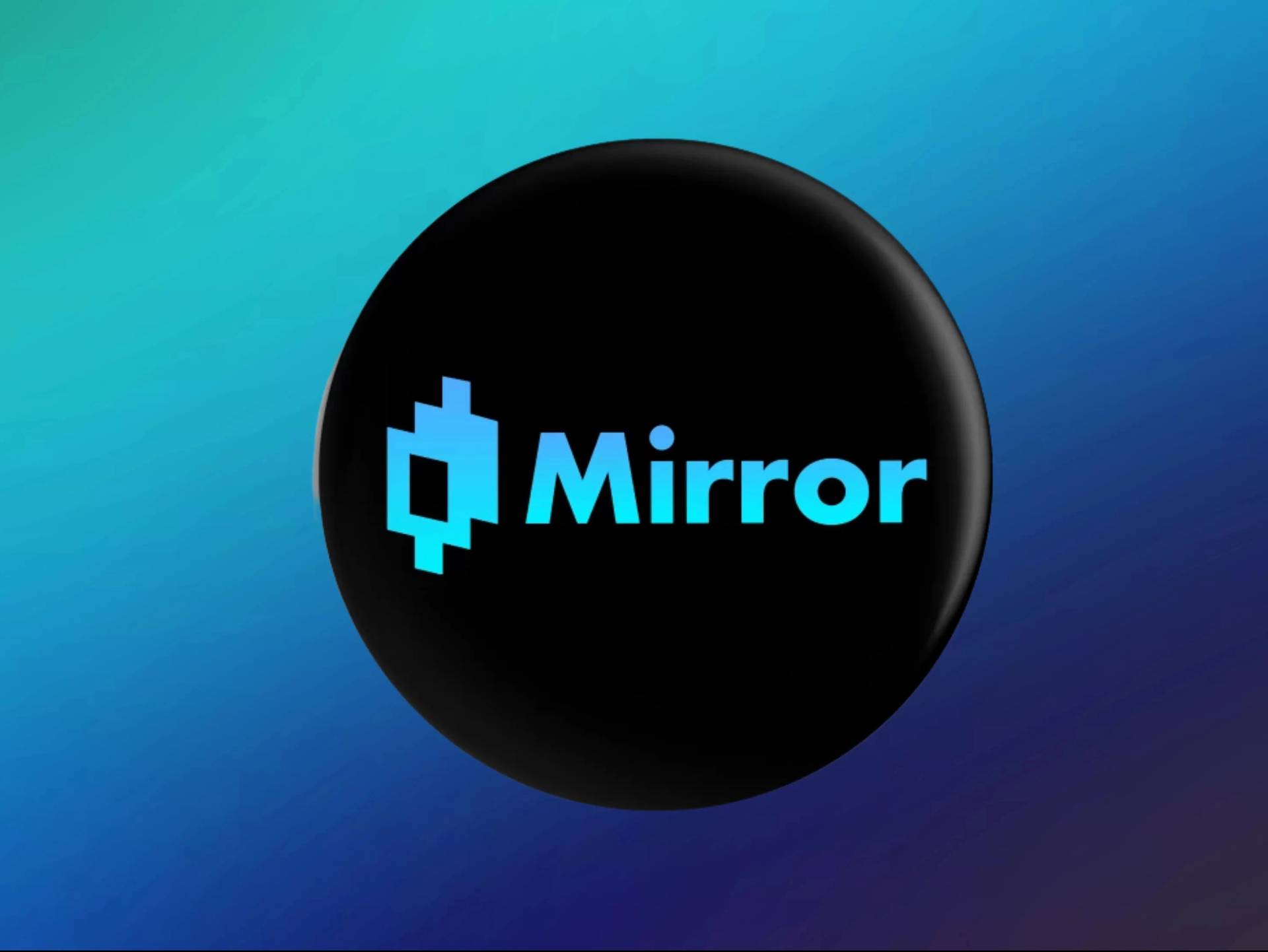Mirror Protocol
미러 프로토콜(MIR)은 테라 네트워크의 스마트 계약을 기반으로 하는 탈중앙화 금융(DeFi) 프로토콜로, 합성 자산인 mAsset을 생성할 수 있습니다. mAsset은 실제 자산의 가격 변동을 모방하며, 거래자는 실제 자산을 소유하거나 거래하지 않고도 가격 변동에 대한 노출을 얻을 수 있습니다[1][2].
개요
미러 프로토콜은 체인 간 탈중앙화 금융(DeFi) 프로토콜로, mAsset이라고 하는 합성 자산을 생성할 수 있습니다. mAsset의 생성은 탈중앙화되어 있으며, 네트워크 전반의 사용자가 포지션을 열고 담보를 예치하여 수행합니다. 미러 프로토콜은 mAsset을 충당할 충분한 담보가 항상 프로토콜 내에 존재하도록 보장하며, 테라USD(UST)에 대해 mAsset의 시장을 관리합니다[3].

mAsset 및 프로토콜의 거버넌스 토큰인 MIR에 대한 UST 거래쌍을 구축하기 위해, 미러 프로토콜은 테라 블록체인의 스마트 계약으로 구현된 자동화된 시장 조성자(AMM) 프로토콜인 테라스왑(Terraswap)에 의존합니다. 테라스왑은 토큰 쌍(또는 UST와 같은 네이티브 테라 코인)에 대한 자동화된 시장인 풀을 생성하며, 사용자는 체인 상에서 직접 한 자산을 다른 자산으로 교환할 수 있습니다. 풀은 두 자산의 잔액을 유지하며, 사용자는 보상을 받는 LP 토큰(유동성 제공자에게 제공되는 토큰)과 교환하여 유동성을 제공할 수 있습니다.
MIR 토큰은 프로토콜에 의해 생성되며, 생태계를 보호하는 행동을 강화하기 위한 보상으로 배포됩니다. 미러 프로토콜은 MIR을 사용하여 유동성 제공을 통해 얻은 지분을 가진 사용자에게 MIR을 보상함으로써 유동성 있는 mAsset 시장을 보장합니다. MIR은 투표권을 얻고 프로토콜의 담보 부채 포지션(CDP) 인출 수수료의 일부를 획득하기 위해 스테이킹될 수 있습니다.
MIR 토큰
미러 토큰(MIR)은 미러 프로토콜의 거버넌스 토큰입니다. 현재, 활성 폴에 투표하려면 스테이킹해야 하며, 새로운 거버넌스 폴을 만들려면 예치금으로 필요합니다. MIR 토큰을 스테이킹하는 사용자는 프로토콜 내의 담보 부채 포지션(CDP)에서 담보를 인출하여 생성된 MIR 보상을 얻습니다[3].
MIR은 또한 MIR 및 mAsset에 대한 유동성을 제공하여 생성된 LP 토큰을 스테이킹하여 수익률을 획득하도록 사용자를 유인하는 데 사용됩니다. 수익률은 연간 인플레이션을 통해 새로 생성된 MIR에서 사용자에게 지급되며, 4년 말까지 MIR의 총 공급량이 점진적으로 증가합니다.
MIR 분배
미러 웹사이트에 따르면, 총 3억 7,057만 5,000개의 MIR 토큰이 4년에 걸쳐 배포될 예정입니다. 그 이후에는 더 이상 새로운 MIR 토큰이 공급되지 않습니다.
미러 프로토콜의 시작 시 총 5,490만 개의 토큰이 제공되었습니다. 이러한 토큰의 분배는 다음과 같이 이루어졌습니다.
- UNI 에어드롭: 1,666%(915만 개) 토큰이 유니스왑(UNI) 보유자에게 에어드롭되었습니다.
- LUNA 스테이커 에어드롭: 1,666%(915만 개) 토큰이 LUNA 스테이커에게 에어드롭되었습니다.
- 커뮤니티 풀: 6,666%(3,660만 개) 토큰이 커뮤니티 풀에 할당되었습니다.
인플레이션으로 인해 MIR 토큰의 총 공급량은 4년 동안 증가하여 총 토큰 공급량이 3억 7,057만 5,000개가 됩니다.
4년 말의 분배 구조는 다음과 같습니다.
- 에어드롭: 원래 UNI 보유자와 LUNA 스테이커에게 배포된 에어드롭 금액은 총 토큰 공급량의 4.9%(1,830만 개)를 차지합니다.
- LUNA 스테이킹 보상: 4.9%(1,830만 개)는 미러 프로토콜 출시 후 첫 해 동안 LUNA 스테이커에게 배포됩니다. MIR은 블록 높이 92만 개부터 첫 해 동안만 10만 개의 블록(약 1주일마다 한 번)마다 LUNA 스테이커에게 배포됩니다. 스냅샷은 스테이킹 보상 분배 자격이 있는 사람을 결정하기 위해 10만 개의 블록마다 촬영됩니다.
- mAsset LP 스테이킹: 45.1%(1억 6,727만 개) 토큰은 4년 말까지 모든 mAsset 및 mAsset(mETH) 스테이킹 풀에 배포됩니다. 토큰은 다른 자산과 비교한 가중치에 따라 매일 각 스테이킹 풀(초기에는 미러 및 mETH 각각 13개 쌍)에 배포됩니다.
- MIR LP 스테이킹: 10.4%(3,860만 개) 토큰은 4년 말까지 MIR-UST 및 MIR-UST(mETH) 스테이킹 풀에 고르게 배포됩니다. MIR-UST 쌍은 초기 가중치가 300%로, mAsset의 초기 가중치의 3배입니다. 토큰은 매일 배포됩니다.
- 커뮤니티 풀: 총 MIR 공급량의 34.6%(1억 2,810만 개)는 4년 말까지 커뮤니티 풀에 배포됩니다.
미러 월렛
미러 프로토콜을 사용하여 테라(UST)로 테슬라(mTSLA)와 구글(mGOOGL)을 매수하는 모습
미러 월렛은 ATQ 캐피탈이 관리하는 비보관형 월렛입니다. 미러 월렛을 통해 사용자는 애플, 구글, 테슬라, 넷플릭스, 트위터, 마이크로소프트, 아마존, 알리바바를 포함한 12개의 가장 인기 있는 미국 기술 주식의 가격을 추적하는 합성 자산을 테라USD로 구매할 수 있습니다. 미러 월렛은 미러 프로토콜을 기반으로 구축되었으며, MIR 토큰을 보유한 누구든지 초기 12개의 합성 자산을 넘어 새로운 자산을 도입할 수 있습니다. 제안은 투표에 부쳐지며, 미러의 거버넌스를 담당하는 탈중앙화 자율 조직(DAO)이 제안을 통과시키면 새로운 자산이 추가됩니다[4].
파트너십
2020년 12월 8일, 미러 프로토콜은 크로스체인 데이터 오라클인 밴드 프로토콜(Band Protocol)과의 파트너십을 발표하여, 블루칩 주식, 상품 및 상장지수펀드(ETF)를 포함한 초기 자산 세트에 대한 가격 피드를 통합했습니다. mAsset의 가격이 실제 자산에 고정되도록 하기 위해, 시스템은 밴드체인 탈중앙화 오라클 네트워크에서 15초마다 업데이트되는 밴드 프로토콜의 저지연 및 탈중앙화 오라클을 통합했습니다[5].
2020년 12월 24일, 미러 프로토콜은 고속 2계층 파생상품 거래소인 인젝티브 프로토콜(Injective Protocol)과의 파트너십을 발표했습니다. 인젝티브의 새로운 기능을 통해 사용자는 솔스티스 테스트넷에서 밴드 프로토콜의 오라클을 기반으로 탈중앙화 방식으로 90조 달러 규모의 주식 시장에 접근할 수 있습니다. 테슬라, 에어비앤비, 구글, 아마존으로 시작하여 인젝티브는 미러의 시장 가격을 활용하여 전 세계적으로 주식 선물에 대한 접근을 가능하게 하는 플랫폼에 새로운 시장을 계속 추가할 것입니다[6].
